FRIEND FROM THE
PAST
Veteran gets surprise
call from Second World War Comrade
By Harry Sullivan Truro
Daily News, Truro N.S.
After 60 years of being out
of touch with his Second World War bomber Pilot, Arthur (Bert) Clissold
knew it would be a long shot to ever track him down. But after placing
a small bulletin seeking information about the Pilot in the Royal Canadian
Legion’s own publication, Legion, Clissold was taken completely by surprise
when he received a telephone call from his former Captain.
“It was remarkable, I thought
it was amazing,” the Truro veteran said. “I had no idea where he lived,
or in fact, if he was alive when I put the ad in… I tell you why, because
the average age of veterans now is 82 or 83 and then they die.”
But as Clissold found out,
his former pilot Robert Brodie, 89, is alive, well, and residing in Montreal.
“He surprised me by calling me knobby (Clissold’s Air Force nickname) instead
of Bert,” he said.
Clissold, who served on a
bomber as a wireless operator/air gunner, was injured during a wartime
flight and now suffers from deep vein thrombosis in his leg, a painful
debilitating disorder that cases major blood clots.
After being refused a disability
pension from the Department of Veteran’s Affairs because of a lack of information,
Clissold decided to run his small advertisement to see if he could locate
Brodie, or other members of his crew, to help substantiate his claim.
While catching up on the
news in their lives, Clissold said he learned that Brodie had been sitting
in a Montreal church one Sunday morning when a friend tapped him on the
shoulder to say he had seen the former pilot’s name in the Legion magazine.
Brodie has since forwarded
information taken from his pilot’s war-time log that backs his former crewman’s
version of events and Clissold is appealing the denial of his disability
claim. But the main reason for sharing his story is to proclaim the value
of the Legion magazine and encourage other veterans to keep trying in their
quest to locate old friends and comrades.
“The point that I’m trying
to make is that any ex-servicemen or veteran that would like to get in
touch with other veterans … to not give up hope.” He said. “They can turn
up some of their pals with whom they served.”
As for the disability pension,
Clissold said he has no intentions of abandoning that effort. If they turn
me down, I’ll try again,” he said. “The only way I’ll give up is if they
look in the obituaries and read my name.”
(Bert was injured at 24
OTU Honeyborne)
August 14, 2004 Reunion
SALUTE TO THE AIR GUNNERS
Dear Mr. Moyles:
As a member of the executive
of an Ex-Air Gunners Association Branch, we hope that you will be interested
in an event that our museum will be hosting on August 14, 2004. We invite
you and all members of your branch to attend.
As you know, the gun turret
of a Bomber Command aircraft during World War II was the coldest, loneliest,
place in the sky and one of the most dangerous. This summer our special
event at the Nanton Lancaster Air Museum will focus on the contribution
of the air gunners to the successes of Bomber Command. The completion of
the restoration of our Bristol Blenheim turret will compliment the three
Fraser-Nash Lancaster turrets and the Martin 250 currently on display.
This impressive collection of five gun turrets will be the backdrop to
our salute to the individuals who manned them in the cold, dark, and dangerous
skies sixty years ago.
We are hoping that as many
ex-air gunners as possible will be joining us on August 14th to be honoured
on behalf of the tens of thousands of their comrades who fought in the
night skies over enemy territory.
As part of this event we
will be focusing on F/Sgt. Peter Engbrecht CGM and F/Sgt. Gordon Gillanders
DFM who flew with No. 424 Squadron. They were undoubtedly the most successful
gunnery team in the RCAF accounting for nine confirmed and two probable
enemy aircraft. F/Sgt. Engbrecht was the only Canadian “Ace” during the
Second World War who was not a fighter pilot. During his second operation
the aircraft was attacked fourteen times by German night-fighters in a
running battle from the target back to the English coast. Sgt. Engbrecht
shot down two enemy aircraft that night, the second with only one of his
four guns in operation. For these and other actions he was awarded the
Conspicuous Gallantry Medal, one of only eight presented to Canadians during
the war. We are pleased that members of the Engbrecht and Gillanders families
will be joining us on August 14.
Our “Salute to the Air Gunners”
will take the form of a luncheon in the museum followed by various tributes
to the Air Gunners. As part of the program we will be unveiling a commissioned
painting by well-known aviation artist John Rutherford depicting Sgt. Engbrecht
and Sgt. Gillanders in action. Following the ceremonies flypasts of various
vintage and modern aircraft will salute the air gunners.
For additional information
regarding our museum please visit www.lancastermuseum.ca and in particular
our “Past Special Events” section that documents our numerous successful
special events of previous years and our “Air Gunners” section.
Please let us know if you
will be able to join us on August 14th. I can be reached through the addresses
listed above or directly by telephone at (403) 646-2681 (evenings).
Yours truly,
Dan Fox, President
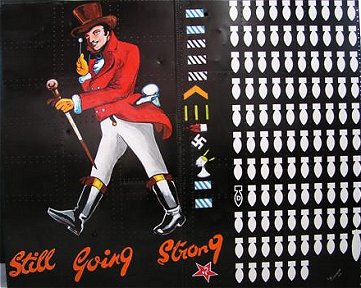
"Johnny Walker" was painted
on Lancaster W-4964, WS-J of No. 9 Squadron, Royal Air Force.
The aircraft had a distinguished
career, logging a total of 106 operations.
Likely the most detailed
piece of work of the war, it features the Johnny Walker whiskey symbol
with the firm's equally famous motto, "Still Going Strong." The artwork
includes the ribbons from four DFM's and two DFCs that were awarded to
her aircrew. The chevron indicates a year's service on active duty. Below
are three wound stripes, one for a container of fifty, four pound incendiary
bombs that were dropped from above and passed through the aircraft's wing.
Below these is the ribbon for the 1939-1945 star medal followed by a swastika
indicating an enemy fighter shot down and a marking for a searchlight that
was shot out at low level. The bomb tally indicates 104 regular night operations,
one day operation, and a larger bomb indicating the 12,000 pound "Tall
Boy" bomb dropped by J-Johnny that struck the battleship Tirpitz on the
aircraft's 100th operation. The red star recalls the aircraft's visit to
Russia en-route to bombing the Tirpitz.
This replica of the nose
art from "Johnny Walker" was painted by Clarence Simonsen on a wing panel
from a Canadian-built Lancaster.
TOURS - How were they determined?
Ed. - A number of years
ago Doreene and I were attending a square dance weekend at Rawlins Wyoming,
USA. We were enjoying dinner with the caller, Johnny Leclair when he noticed
the Ops wings on my jacket. He asked what the wings represented. I explained
that it meant 30 operational trips in Bomber Command or 800 operational
hours on Coastal Command. It was then I learned that Johnny had been a
USAF B25 pilot flying bombing strikes out of Italy. He laughed and said,
“we were not that fortunate, there was no limit to how many we flew. Johnnie
called square dancing in locations around the world. He recalled being
invited to call in a city in Germany which he had visited years before
in his B25 bomber. He said, “I didn’t tell them that I had been there before.”
This leads into the following
articles regarding the calculation of tour time during the war.
Short Bursts December 1992
Issue #40, Don Daikens writes in part: “In regards to Maurice Winton’s
article on page 7 of the latest Short Bursts, I have never heard of anyone’s
tour being counted other than by sorties and never by hours.”
This statement generated
a number of replies in the following Newsletter.
John R. Low, Chemainus, BC.
In answer to Don Daikens
letter about how a tour was counted. There are lots of things you never
heard of, especially in the services. Here goes: RAF Squadron 570 tour
consisted of (get this) either of these:
1 - 18 months on operations.
2 - 500 hours on operations.
3 – 30 operational trips
over enemy territory.
My tour with 570 Squadron
ended up like this:
18 months on operations.
499 hours on operations.
31 trips over enemy territory.
You can see from this it
was calculated very closely. If you think it was easy try towing a glider
on D-Day, Arnhem (3 trips) and crossing of the Rhine (one trip), (2 to
France on D-Day). In addition to this you can add night trips to almost
anywhere in Norway, Holland, Denmark, France, via Mk 1V Stirling, one aircraft
to one dropping zone in the middle of the night in any kind of weather.
All dropping done between 500 and 1000 feet. Sometimes containers to Marauis,
sometimes special SAS troops, sometimes 500 lb bombs. The tail turret was
the only armament on the Stirling, every other defence was stripped from
it.
Hopes this clears up some
of your doubts Don.
Art Colston writes: Don Daikens
writes in the December Issue that he has never heard of a tour being counted
in anything but sorties. Well, Coastal Command counted their tour expired
people in hours. I am one.
E.M. Cooke writes: in response
to Don Daikens article: Bomber Command, in their great wisdom, decreed
a tour as thirty trips or two hundred hours, whichever came first. I completed
a tour with 102 Squadron with 29 trips and 201:55 hours.
The grand old Whitley had
a cruising speed of 125 mph indicated and here are a couple of examples
between it and a Halifax.
116-7-41 Whitley – Bremen
7:55
6-25-42 Halifax Bremen 5:55
11-1-41 Whitley Kiel 7:55
4-28-42 Halifax Kiel 6:30
The longest trip was to
Nurnberg 10:25. All thee trips were from Topcliffe which, I believe, later
was a 6 Group Conversion Unit.
I was sent to 190 OUT at
Kinloss and then out of the blue in August ’43 was sent on pilot’s
course. There were six other WO W/Ags and fourteen commissioned RCAF W/Ags.
We received our wings at Souris, Manitoba. Maybe some of the fourteen are
out there reading this, so hello to them nearly fifty years later.
E.M Cooke
1516 Blaine Ave., N.E. Renton,
Washington 98056. USA. (Reader, please realize this was written in March
1993)
Those were the days when
Members responded to articles in the Newsletter. But, let's face it, we
were years younger then!
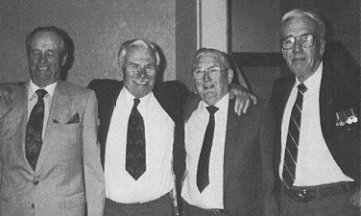
TS “Tommy” Taylor.
Pat Miller, Tommy Cousins, John Moyles
Winnipeg 1992
~ Ex - WAGs All
SHORT BURSTS June 1991
– Issue #34
The following is of interest
due to the international news we receive daily.
Pat Miller (deceased)
Our Catalina flying boat
crew of nine had been engaged in ferrying similar aircraft from Oban Scotland
to Kozangi Creek, India, nine miles from Karachi (now Pakistan). On leaving
Oban we flew directly to Gibraltar. From there to Djerba, Tunisi, and on
to Kasfareet, Egypt. By now we had circumvented Europe. Hence over present
day Israel and on to Lake Habbaniya an RAF Station twenty miles from Baghdad.
Next stop was Bahrain (old spelling), Saudi Arabia, and then on to Korangi
Creek.
A year before Habbaniya had
been under siege by the Iraqis but successfully defended by the British
army. Many of the places are prominent in the news today (May 1991).
While stationed in India
and Ceylon we had the novel experience of flying THE LOCUST PATROLS. These
flights took place in searing heat, violent turbulence, through mountain
valleys, at ground level, with no detailed maps – in a flying boat!! There
was a constant battle with the controls in an attempt to keep the aircraft
at 50 to 100 foot altitude, under constant threat of dead end canyons and
loss of room to manoeuvre. All factors considered you got the feeling that
you had a couple of guys at the controls who actually knew what they wee
doing. I must pay tribute to F/L Eric Kenny, Captain, and “Blackie” Glaister,
second pilot, with whom anyone would be proud to fly.
We were briefed as to the
area to be covered and what to look for, (we never did know). None of us
knew what a locust looked like from 100 mph so we were assigned an Indian
Government Entomologist to accompany us and do the normal sighting reports.
Our locust flights were over
Northern India, (now Pakistan) and Afghanistan. After take off we were
into another age. Up narrow valleys, hopefully with exits or at least room
to turn around, villages of mud huts, women clad to their eyebrows working
in fields that looked as brown as the surrounding mountains. And men! God
help us if we ever had to sit down. As it was all they could do was hurl
rocks at us.
On occasion we would come
upon a placid village with a herd of sheep milling about. These animals
were instantly turned into projectiles – mowing down tents, humans, and
everything in their path. One time we turned down a valley in Iran barely
missing a farmer with two oxen ploughing a green area. The last we saw
of him, he was shaking his fist at us and his animals were heading for
the hills.
On one trip we had the rare
and distinct honour to have a pleasant young female along to look for the
bugs. After hours of fighting the controls our pilots took a well
earned rest, set “George”, and thought about dozing on the way home. Somehow
this new young thing took to wandering fore and aft, each time with a number
of crew tagging along close behind – sometimes called “hovering”. This
naturally played havoc with the automatic pilot. One minute a nose up attitude,
the next a nose down. Naturally this brought a snarl from both Eric and
Blackie, normally docile types.
Near the end of June 1945
we had the welcome news that all RCAF crews in S.E. Asian theatre were
grounded. Our Group in Ceylon were to embark at Bombay for a sea voyage
to Southampton, and our crew were designated to transport Canadians to
Bombay. However, I took advantage of the grounding order, declined to take
part, and instead, took a leisurely five day trip by train to Bombay, where
I rejoined my crew and enjoyed a seventeen day trip to England.
Don Macfie
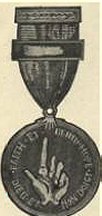
It was with some interest
that I read about the M.H.D.O.I.F award. I got out my log book and diary
to see if I really had a “gong” to put ahead of my “spam”. What tales I
could tell on remembrance day when some school kid pointed to it and said,
“and what is that one for?”
My log book is written as
if to save ink. My diary says to hell with rationing.
Log Book 18:4:42 - Hudson
#400 - P/O Russell. F/O Ritchie, and self. Altitude test. Stbd engine U/S
at 14000 ft.- leaking oil. -----------------------:50 min.
Diary
Debert N.S. Training for Ferry Command. A nice day, we were sent
up on an altitude test to 25000 ft. We circled up over Truro. Bert climbed
pretty fast and at around 15000 ft. the Stbd. motor seized and was boiling
oil. Smoke was rolling out and coming into the cockpit through the floor.
It looked bad and gave us quite a scare. I got a “P” message out in a hurry.
The oil ran out to the prop which threw oil in all directions.
Bert told me to go back in
the fuselage to get Jack’s and my parachutes. There was only one there
where there should have been two, it was Jack Ritchie’s. I grabbed it by
the D ring and it opened. There I was drowned in silk!
We got back to base on one
engine ok and even found that it would climb on one engine. I found my
parachute in my locker where I had left it, and had to pay .50 cents for
having Jack’s repacked.
I am now wondering what a
“P” message was. Maybe some WAG out there will remember.
Carman Brown
Carman Brown 429 Sqdrn.
Rear Gunner.
Who said we didn’t carry
a full load of bombs!
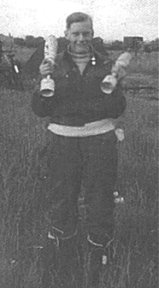
WOMBLETON HCU 1666
You not only made friendships
with your own crew members but also with other chaps in the same trade
and ranking; Officers to Officers and NCOs to NCOs, A/Gs to A/Gs etc. My
crew buddy Frank McNally and I had welded a friendship with Larry Bucoviz
and Art Reichman, all Airgunners, through our training at the OTUs Dalton
and now Womleton (on/in the mud).
During May 1944, for some
unknown reason FRESH YELLOW LEMONS were handed out at noontime
mess and the four of us made plans to visit the village later that evening
and cast our lemons into the barter system. After supper the four of us
trudged into the Village with high hopes of doing a landslide business,
after all, when was the last time anyone had a lemon. We were rudely brought
back to earth as a number of guys had already flooded the market
with lemons.
On our trip into the Village
we had noticed a chicken coop. Not to be outdone, or return to our hut
empty handed, we decided to scout the situation with this hen coop. Two
brave souls stood guard at the road while two safecrackers nabbed two chickens.
Being fairly dark, the birds did not make a squawk as they were stuffed
into the battle dress blouse. The trip to our hut became a quick march,
better known as a dog-trot.
Now the fun began; how do
you stuff a Rhode Island Red (?). Well, according to the two BC boys, Larry
and Art, just grab the neck and give a couple of twirls – nothing to it.
Now the plucking of the feathers and gutting. The language was fierce,
the hooting and hollering out of this world.
The little stove was roaring.
The mess tins greased. The lemons sliced just waiting for the pieces of
chicken to be fried. We started out with four lip-smacking A/Gs but two
WAGs wanted to join the feast. It was well past 10 p.m. – the meal, washed
down with suds from the SGT Mess, was quite good. Our big problem was getting
rid of the residue – someone opened the stove and dumped feathers and guts
into the hot flames --- what a horrendous putrid odour. It took several
days to get rid of the stench.
This story is to prove that
four A/Gs in the RCAF were the first Canadians to kitchen test and eat
Lemon chicken a la Wombleton. No after effects - that was sixty
years ago.
Larry Bucoviz and Art Reichman
completed a tour with 424 Squadron. Larry lives in Burnaby, BC, 604-298-7337.
He would like to hear from his buddies. Frank McNally and I completed our
tour with 429 Squadron.
Thanks. Carman Brown
Cama107@sympatico.ca
Bob Henderson has asked if anyone can identify this
pin.
7m tall, 4.5 cm wide
Reverse marked “ARO STERLING”
Long thin vertical pin with clasp on reverse.
The German Eagle between Britannia and the Soviet Hammer,
Sickle, and Star.
You can contact Bob at:
HOME FRONT ARCHIVES AND MUSEUM
Robert J. Henderson
6015-15th Ave.
Regina, SK S4T 6V4 Canada
Phone: 1.306.543.5822
|
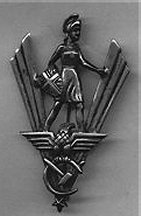 |
CORRESPONDENCE
Norm Muffitt
Ted Hackett thought you might be interested in this
old 201 Sqdn photo taken at Castle Archdale in either late 1942 or the
spring of 1943:
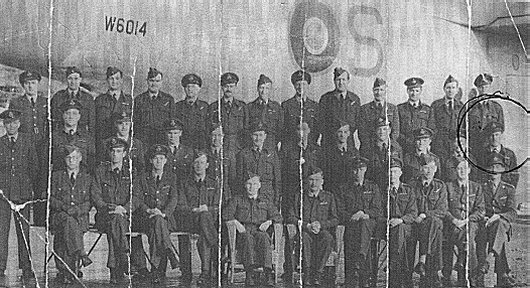 Front row seated:
Front row seated:
F/L Norris, F/L Fairclough,
F/L Hewitt, S/Ldr Flint, W/Cmdr J.D. Burnett, S/Ldr Bunting, F/L Sanderson,
F/L Harvey, F/L Hayes, F/L D. Gall, Capt. Shelton
Middle Row
F/O Harcourt-Williams, F/O
Matthey, F/O Robertson, F/O Louth, F/O B.E.H. Layne, F/O Gallemaerts, F/O
Robinson, F/O Lingard, P/O Mold, F/O Bates, F/O Harrild, F/O E.E. Muffitt
Rear Row
F/O Hamer, P/O Jay, P/O
HJodgson, F/O Davies, P/O Hewett, F/O Dunn, F/O Walters, F/O Wood, P/O
Willert, P/O Alexander, F/O Stevens, P/O Harvey, F/O Dawson
There may be the odd spelling
error but other than the spelling for Muffitt I have reproduced the names
exactly as I received them from Ireland. I do have a bit of history on
some of the individuals shown if you are interested.
Norm submitted the following
pictures from his Dad’s collection.
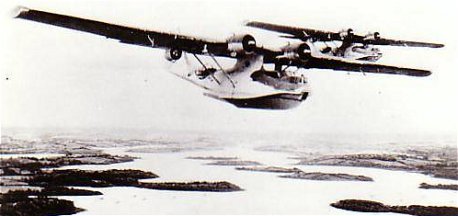
Catalinas – Killadees
– 1941
Ted Hackett
I was reading through some
old copies of Short bursts and came across the article by "Smokey" Robson,
in the April 2002 issue, regarding the attack on the German battleships
Scharnhorst and Gneisenau. I have a friend in New Zealand, S/L D.S.N.Constance
RNZAF (ret'd) who was one of the first pilots to serve with 408 Squadron
and who took part in the attack and actually engaged the target.
He said that he could tell where they were by the flak coming up through
the cloud. He took his Hampden down out of the clouds at 200 feet
and was subjected to such severe fire from the ships that serious damage
was done to his aircraft including the loss of the port aileron.
Despite the damage to his
aircraft, he could no longer take evasive action, he pressed home the attack,
made a run over the ships and dropped his bombs from 800 feet. The
Hampden was hit repeatedly, the cockpit wrecked, the instruments destroyed
and the wireless equipment rendered unserviceable. A shell came up though
the fuselage and went right between the legs of the WAG and out through
the roof. The chances of getting back to base seemed remote but through
the skill and zeal of F/O R. Van den Bok, WAG, and P/O R.J.Hardingham,
Nav, they managed to reach the UK.
I remember him telling me
that he had to hold the control column hard right to keep flying level
and he said, " when we finished the run I just let go of the wheel and
she turned port and headed for home". All members of the crew received
the DFC.
We first met "Tinny", as
we knew him, when he arrived in Edmonton for the 1984, 408 Squadron reunion.
He returned to Canada again for reunions in 1988 and 1992 and came to stay
with us on both occasions. He resides now in Whangerei, NZ, on the
north island and we correspond regularly.
Here is the photo I mentioned,
It is the damage to the port wing of S/L Constance’s aircraft after the
attack on the battleships.
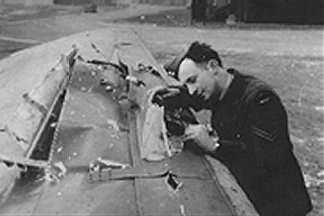
Ross Hamilton.
Beginning on page 16 (April
Issue) is an article from Gordon Hobbs regarding his father Charlie Hobbs.
(Small world again!!)
I knew Charlie Hobbs very
well for many years when we were residents of Peterborough, Ont. for some
35 years. We belonged to the same clubs etc., and I corresponded with him
when he was in Sunnybrooke Hospital. I had lost track of him, but his name
turned up in an issue of Short Bursts of years ago. I knew he had passed
away, and I have his book "Charlie's Story". Well done.
Rebecca Trissler
The story in this month's
issue (April – Plane VS Sub.) was fascinating, and not in the least because
it was written by the PR officer who died in my grandfather's plane crash,
F/O David Griffin. I always love reading those stories and you have
no idea how much it has helped me getting things "straight from the horse's
mouth" so to speak. I started this project thinking how easy it would
be to write those sections and they ended up being the hardest of all once
I realized how little I actually knew.
I am in the middle of finishing
up the novel right now as a matter of fact but don't expect it to come
out until next year in the late spring or early summer. The back-end
process seems to take an enormous amount of time but then that's what we
must live with I suppose. I will definitely be in touch with you
when I expect to see galleys and will forward a copy to you at that time,
and of course would be thrilled to have you review it for Short Bursts.
Best to you and all the gentlemen
who helped me along my way--
Rebecca
trissler1971@yahoo.com
Ed. Rebecca is writing
a story regarding her Grandfather who was KIA on Coastal Command. Some
of our members have corresponded with Rebecca, Glen Clearwater and Ross
Hamilton to name two. We look forward to her finished work.
From: Peter Wilson Cunliffe
To: webmaster@airmuseum.ca
Sent: Sunday, April 04,
2004 2:07 PM
Subject: Pilsen Raid 1943
Lanc R5622
My Uncle was lost on the
same raid as R5622 on the Air Gunners site. You may be interested in my
site. Conversely anything on any aircraft crew or detail about this raid
would be appreciated.
Peter
http://mysite.freeserve.com/pilsen_raid_1943
(Peter is referring to
the April article on Charlie Hobbs)
Dear Mr Moyles,
I was delighted to come across
your Short Bursts web site just now. I am doing some research on
allied and axis servicemen who were interned in Ireland during WW2, and
write in the hope that some of your members may be able to help me.
I would be very interested
to hear from anyone with memories or information about Mr William A. Proctor,
an RAF pilot who I understand was held at the Curragh camp from about Christmas
1940 until he escaped to Northern Ireland in July 1941.
Any help at all would be
much appreciated.
With many thanks.
Yours sincerely,
Deborah Cherry
33 Shuttleworth Road
Preston
Lancashire
PR1 6DB
UK
A Request from Nancy O’Shea
William Leslie O’Shea
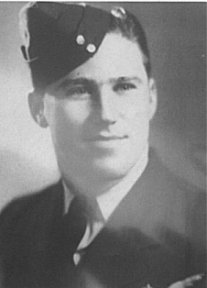 Here
is a scanned photo of my father. His name was William Leslie O'Shea.
He was born in Ottawa in 1922 and died in Seaforth, Ontario 1990.
Here
is a scanned photo of my father. His name was William Leslie O'Shea.
He was born in Ottawa in 1922 and died in Seaforth, Ontario 1990.
He was a mid-upper gunner
during the second world war. He was part of the Pathfinder Force
Group (8) based at Gransden Lodge. I have a copy of his log
book and he was stationed at the following locations:
100 Squadron Grimsby
23/11/44 - 27/2/45.
P.N.T.U. Warboys
#156 Squadron Upswood
27/3/45 to dates unknown.
Finally, Gransden Lodge,
Pathfinder Force (8) Group 8/3/45 until the end of the war.
The name of the crew members
are as follows:
William O'Shea mid-upper
gunner,
Jack Willis rear-gunner,
Alan Templeton wireless
operator,
Jack Scholey pilot,
Albert Amies bomb aimer,
Don Lennox navigator.
If anyone has any memories
or recollections of William O’Shea, please contact Nancy O'Shea - Moses
at jmoses@telus.net or you can also
reach me at
250-658-8370 (please call
collect).
My mailing address is:
977 Owlwood Place
Victoria, B.C. V8X 4T3.
Special thanks to Penny Willis
for providing me with names and phone numbers. Please include this in your
May issue.
BRANCH REPORTS
FAITHFUL AS EVER, Smokey
Robson, President of the Northern Saskatchewan Branch, phoned to say their
monthly luncheon was well attended with 22 members enjoying the camaraderie.
Editors Report
It will be noted there is
more Correspondence in this Issue. Children and grandchildren of Ex-servicemen
are now searching for information relating to family veterans. Read these
carefully, check your log book, you just may be able to help. If you served
on the same Squadron or training base, a letter would certainly be appreciated.
August 14, 2004. Mark your
calendar. We will see you at Nanton Lancaster Society Hangar, Nanton, AB.
Who said Sept. 2000 was our last reunion.
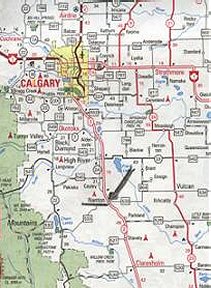
There will be more Gen in future Issues.
Thanks to all who contributed to this Page.
Keep well.
John & Doreene Moyles – Editors
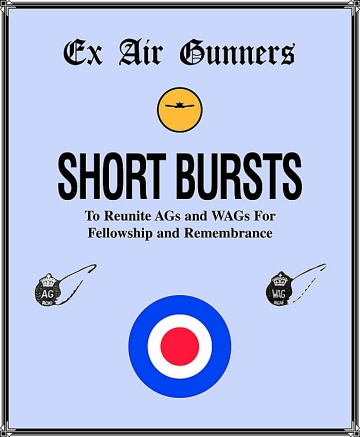



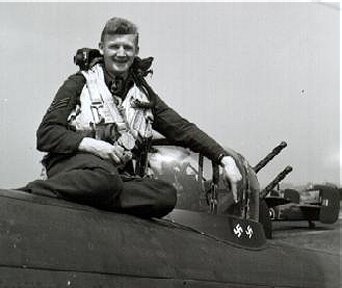
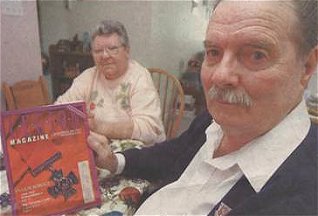
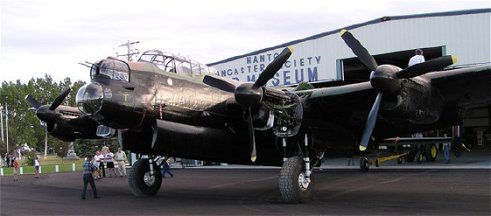
![]()
![]()
![]()
